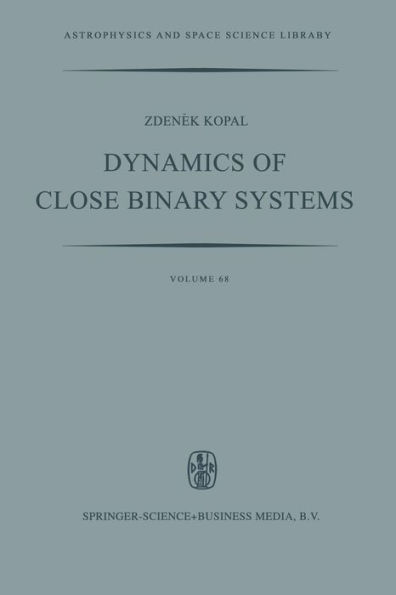5
1


Paperback(Softcover reprint of the original 1st ed. 1978)
$54.99
-
PICK UP IN STORECheck Availability at Nearby Stores
Available within 2 business hours
Related collections and offers
54.99
In Stock
Overview
The aim of the present book will be to provide a comprehensive account of our present knowledge of the theory of dynamical phenomena exhibited by elose binary systems; and on the basis of such phenomena as have been attested by available observations to outline probable evolutionary trends of such systems in the course of time. The evolution of the stars - motivated by nuelear as weIl as gravitation al energy sources - constitutes nowadays a well-established branch of stellar astronomy. No theo ries of such an evolution are as yet sufficently specific - let alone infallible - not to require continual tests by a confrontation of their consequences with the observed properties of actual stars at different stages of their evolution. The discriminating power of such tests depends, of course, on the range of information offered by the test objects. Single stars which move alone in space are now known to represent only a minority of objects constituting our Galaxy (cf. Chapter 1-2); and are, moreover, not very revealing of their basic physical characteristics - such as their masses or absolute dimensions. If there were no binary systems in the sky, the only star whose vital statistics would be fully known to us would be our Sun.

Product Details
| ISBN-13: | 9789400997820 |
|---|---|
| Publisher: | Springer Netherlands |
| Publication date: | 10/12/2011 |
| Series: | Astrophysics and Space Science Library , #68 |
| Edition description: | Softcover reprint of the original 1st ed. 1978 |
| Pages: | 513 |
| Product dimensions: | 6.10(w) x 9.25(h) x 0.04(d) |
Table of Contents
I. Binary Stars in the Sky.- 1. Binary-Star Population in our Galaxy.- Bibliographical Notes.- II. Figures of Equilibrium.- 1. Equipotential Surfaces.- 2. Rotational Distortion.- 3. Tidal Distortion.- 4. Interaction between Rotation and Tides.- 5. Effects of Internal Structure.- 6. Gravity, Density Distribution, and Moments of Inertia.- Bibliographical Notes.- III. Dynamical Tides.- 1. Equations of the Problem.- A. Dissipative Systems.- B. Radiating Systems.- 2. Linearized Equations.- A. Viscous Spheroidal Deformations.- B. Boundary Conditions.- C. Homogeneous Model.- 3. Forced Oscillations: Dynamical Tides.- A. Mass-Point Model.- B. Centrally-Condensed Model.- C. Disturbing Potential.- 4. Dissipation of Energy by Dynamical Tides.- A. Viscous Friction.- B. Application to Binary Systems.- Bibliographical Notes.- IV. Generalized Rotation.- 1. Equations of Motion for Deformable Bodies.- A. Eulerian Equations.- 2. Rotation of Deformable Bodies.- A. Effects of Deformation.- B. Moments and Products of Inertia.- C. Coefficients of Deformation.- 3. Effects of Viscosity.- A. Equations of the Problem.- B. Tidal Friction: Spherical Configurations.- C. Tidal Friction: Spheroidal Configurations.- D. Dissipation of Energy by Tidal Friction.- 4. Nonuniform Rotation.- A. Steady-State Rotation; Gravity-Darkening.- B. Non-Steady Rotation.- Bibliographical Notes.- V. Dynamics of Close Binaries.- 1. Equations of the Problem.- A. Perturbation Equations.- B. Evaluation of the Coefficients; Tidal Lag.- 2. Perturbations of the Orbital Plane; Precession and Nutation.- A. Effects of Viscosity.- B. Linearized Case.- C. Secular and Long-Periodic Motion.- D. Solution of Equations.- 3. Perturbations in the Orbital Plane.- A. Secular Perturbations: Rotational Distortion.- B. Secular Perturbations: Tidal Distortion.- C. Apsidal Motions: Comparison with Observations.- 4. Period Changes in Eclipsing Binary Systems.- A. Generalized Law of Areas.- B. Orbital Period: a Definition.- C. Relation between Orbital Period and Times of the Minima.- 5. Effects of Variable Mass.- A. Generalized Equations of Motion.- B. Isotropic Mass Loss.- C. Non-Isotropic Mass Loss.- 6. Perturbations by a Third Body.- A. Equations of the Problem.- B. Short-Range Perturbations.- C. Long-Range Perturbations.- D. Effects of the Light Equation.- Bibliographical Notes.- VI. The Roche Model.- 1. Roche Equipotentials.- A. Surfaces of Zero Velocity.- 2. Geometry of Roche Surfaces.- A. Radius and Volume.- B. Roche Limit.- C. Geometry of the Eclipses.- D. External Envelopes.- 3. The Roche Coordinates.- A. Rotational Problem.- B. Tidal Problem.- C. Double-Star Problem.- Bibliographical Notes.- VII. Stability of the Components of Close Binary Systems.- 1. Criteria of Stability.- 2. Secular Stability.- A. Rotational Problem.- B. Double-Star Problem.- 3. Dynamical Stability.- A. Vibrations of the Roche Model.- 4. Concluding Remarks.- Bibliographical Notes.- VIII. Origin and Evolution of Binary Systems.- 1. Evolution of the Stars.- 2. Classification of Close Binary Systems.- A. Characteristic Parameters.- 3. Nuclear Evolution of Close Binary Systems.- A. Detached Systems.- B. Semi-Detached Systems.- C. Contact Systems.- 4. Tidal Evolution of Close Binary Systems.- A. Energy and Momentum.- B. Evolution with Constant Momentum.- C. Comparison with Observations.- D. Tidal Evolution.- 5. Beginnings and Ends.- A. Origin of Close Binaries.- B. Terminal Stages: Subdwarf Binaries.- C. X-Ray Binaries and Black Holes.- Bibliographical Notes.- References.- Index of Names.- Index of Subjects.From the B&N Reads Blog
Page 1 of
